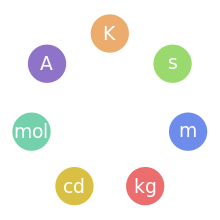Newton second
| newton second | |
|---|---|
|
| |
| Unit information | |
| Unit system | SI derived unit |
| Unit of | Impulse and momentum |
| Symbol | Ns |
| Named after | Isaac Newton |
| In SI base units: | kg ⋅ m/s |
The newton second (also newton-second, symbol Ns or N·s)[1] is the derived SI unit of impulse. It is dimensionally equivalent to the momentum unit kilogram metre per second (kg·m/s). One newton second corresponds to a one-newton force applied for one second.
It can be used to identify the resultant velocity of a mass if a force accelerates the mass for a specific time interval.
Definition
Momentum is given by the formula:
- p is the momentum in newton second (Ns) or "kilogram meters per second" (kg·m/s)
- m is the mass in kilogram
- v is the velocity in meters per second (m/s)
Examples
| Mass (kg) |
Velocity (m/s) |
Momentum newton seconds |
Explanation |
|---|---|---|---|
| 0.1 kg | 10 m/s | 1 Ns | A 100 gram tomato dropped at a height of 1m on the earth (gravitational acceleration of 9,82 m/s2 gives approx. 1 second flight time). |
| 0.42 kg | 2,4 m/s | 1 Ns | A 420 gram football (FIFA specified weight for outdoor size 5) kicked to a velocity of 2.4 m/s (8.6 km/h). |
| 0.42 kg | 38 m/s | 16 Ns | The momentum of the famous fotball kick of the Brazilian player Roberto Carlos in the match against France in 1997. The football had a speed of 137 km/h (38 m/s), making it one of the hardest kicks measured. |
| 1,500 kg | 16.7 m/s | 25,050 Ns | A regular small car weighing 1.5 tons crashing at 60 km/h (16.7 m/s) |
| 2,600 kg | 16.7 m/s | 43,420 Ns | An SUV weighing 2.6 tons crashing at 60 km/h (16.7 m/s) |
| 6 N | 1 s | 6 Ns | The total impulse of a class C model rocket engine, which can be found in amateur fireworks. |
| 10 N | 2 s | 20 Ns | The total impulse of a class D model rocket engine, which also can be found in amateur fireworks. |
| 2,030,000 kg | Space Shuttle launched from earth to orbit | ||
| 45,702 kg | Apollo 11 launched from earth to orbit | ||
| 0.0075 kg | 350 m/s | 2.6 Ns | 9x19 mm 7.5 gram pistol round launched at 350 m/s |
| 0.004 kg | 945 m/s | 3.8 Ns | 5.56 mm (.223) 4 gram rifle round launched at 945 m/s |
| 0.05 kg | 860 m/s | 43 Ns | 12.7x99 mm (.50 BMG) 50 gram rifle round launched to 860 m/s |
See also
References
- ↑ International Bureau of Weights and Measures (2006), The International System of Units (SI) (PDF) (8th ed.), ISBN 92-822-2213-6
This article is issued from Wikipedia - version of the 11/24/2016. The text is available under the Creative Commons Attribution/Share Alike but additional terms may apply for the media files.

